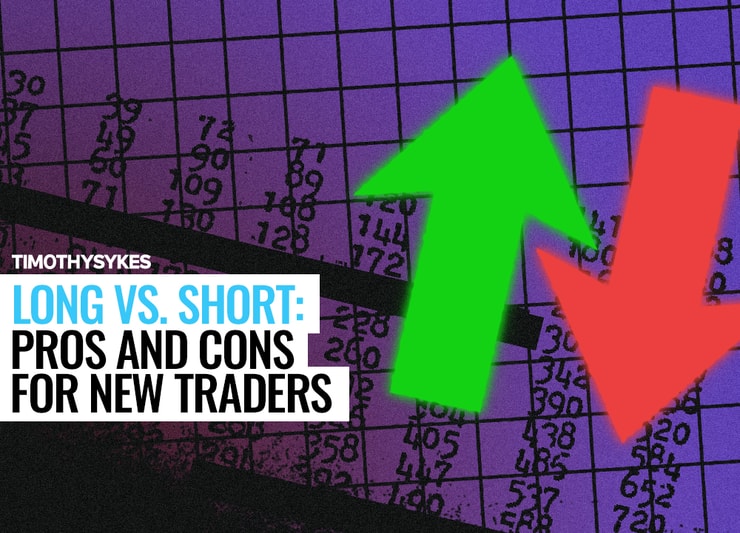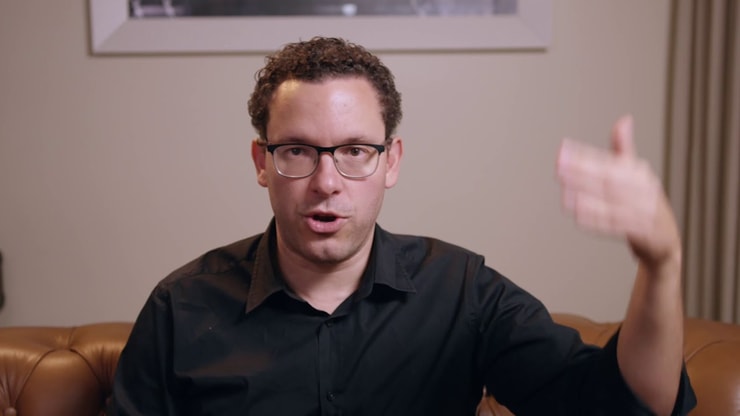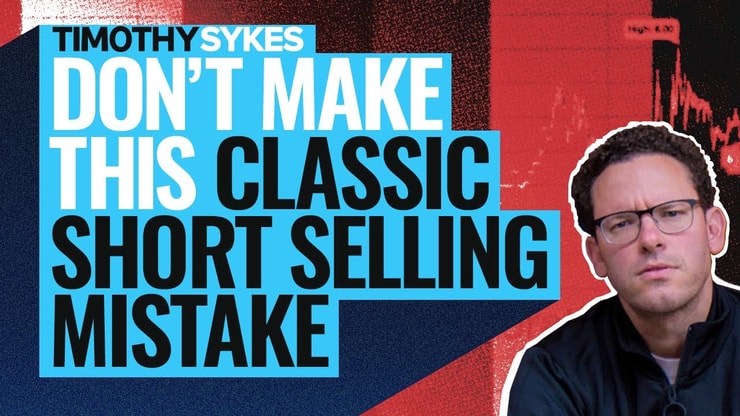Long vs. Short: Which trading strategy is better for new traders?
I get this question a lot. Super-short answer: It’s different for everyone.
In the long run, you want to get good at multiple trading strategies. But in the beginning, it’s smarter to nail down one pattern. Focus on one and find consistency. Then you can test another strategy.
Of course there’s far more to it than that. So in this post, I’ll cover some of the pros and cons of long vs. short stocks.
But first, let’s go over some basics…
Table of Contents
What Is Longing a Stock?
When you go long a stock you’re betting that the stock price will go up. I think this is a better strategy for new traders.
It’s the easiest way to start out in the market. It’s straightforward. You place a buy order when you want to buy and a sell order when you want to sell.
Speaking of buying and selling, I currently trade with these brokers. You can likely use any of them if you plan to go long stocks. But do your own research first. And beware the ‘unlimited commission-free’, discount, or off-shore brokers.
What Is Shorting a Stock?
When you short sell a stock, you’re betting that the stock’s price will go down.
To short, you execute a sell order for shares you don’t own. So you gotta borrow the shares from your broker and take a negative position. When you want to exit your position, you have to buy to cover. Then you’ll have a zero position.
Sound complicated? It is … It’s also risky. That’s definitely worth considering when you’re deciding to go long vs. short. More on risk in a bit.
If you’re confused…
Focus on Your Market Education
Too many people get into trading because they want to make quick money. Trust me, I’ve seen this with a lot of recent applications to my Trading Challenge…
Don’t get me wrong … I think it’s great that some of you are using your time in the coronavirus lockdown to find ways to make money other than selling your time to someone else…
But I’ve had to reject a lot of applicants because they don’t have the right mindset.
There’s a reason I make people apply. I don’t want lazy students or traders thinking this is how they’ll get rich quick. I’m looking for students who take their education seriously. If you think you’ve got what it takes to be part of the Challenge, apply today…
But be prepared to work and learn. Because the best lessons you’ll learn won’t be about money. You gotta dedicate yourself to learning the patterns and nuances of the market. And be prepared to not make money in the beginning.
My Teaching Strategy
I think you should treat learning to trade the same as you would a college or university course. You have to give yourself time to learn the process. Think about it…
It takes most people four years to get a bachelor’s degree. A medical doctor spends between 11 and 14 years on their education. It shouldn’t take that long to learn how to trade and become consistent. But it’s NOT a get-rich-quick scheme. So be prepared to study for a few years.
So what’s my philosophy on long vs. short strategies?
I teach my students to be self-sufficient. You have to find what works best for you.
My Trading Challenge isn’t about hot stock picks. I have trade alerts, but they aren’t for anyone to follow. It’s about learning the process. I alert my chat rooms so they can understand my thinking.
Start learning my process … Access my FREE penny stock guide here and sign up for my free weekly watchlist here.
(You can learn my trading indicators in my “Trader Checklist Part Deux” DVD. Study and learn them until they’re embedded in your brain.)
I used to primarily short stocks, but these days, I’m long biased. It’s partially to help newer traders learn the process. It’s also because shorting is overcrowded and risky these days.
Most new traders come to the market just to make money — they don’t follow rules or a process. So I try to protect you from yourself by teaching simple patterns and conservative strategies.
Build your knowledge account and gain experience. Then you can explore other strategies. For now, think about what you can do in the next week, month, six months, or a year. What can you do to improve your knowledge and trading?
Remember, this is a marathon, not a sprint. You can’t rush the process, and everyone learns at a different pace.
Now let’s take a look at the pros and cons of going long vs. short…
You can never be guaranteed of profits, but without preparation and studying ahead of time you can most certainly be guaranteed to fail like most wannabe traders do…so do the opposite of what those lazy sacks of shits do and simply get obsessed with studying the past & charts!
— Timothy Sykes (@timothysykes) April 23, 2020
Long vs. Short: Pros and Cons
Going Long
Again, when you go long, you buy a stock anticipating that it’ll go up. Buy low, sell high. Well, it’s not that simple. Let’s look at the pros and cons…
More Breaking News
- CleanSpark Inc. Stock Shake-Up: Is Crypto Scrutiny To Blame?
- TeraWulf Inc. Shares Plummet Amid Security Filing and Crypto Drop: Time to Invest or Cut Losses?
- Market Whisper: Is Canaan Inc. a Hidden Gem Amidst Recent Gains?
Pros
The biggest advantage of going long is it’s a simple trading strategy. You don’t need a special broker. Anyone can open an account and buy and sell. It’s straightforward.
Because of that, there are more long-biased traders in the market than short sellers. But shorting is becoming more popular.
Which brings me to the next pro of going long…
The Short Squeeze
Coronavirus stocks are hot right now. What can spike them even higher? Over-aggressive short-sellers. They short coronavirus plays on the first day after the company has news. These traders think all penny stocks are junk and will fail.
That creates massive short squeezes. And prepared longs can ride the momentum up. The funny thing? The short-sellers are usually right. In the end, these stocks usually fail. But you never know how high these stocks can go — especially with news, hype, and a low float.
You must understand what makes stocks move. If you’re going long, you gotta understand the short side too. Where will short sellers enter and exit? Use that to your advantage.
I love morning spikers with a quick upside move. I’m an impatient trader … I like to be in and out FAST. You have to consider how long you want to hold when determining which strategy will work for you.
The Top Long Strategy for New Traders
The morning panic dip buy is the top strategy I see right now for new traders. It’s a strategy with great risk/reward.
After a stock has a run-up for a day or two, sometimes you’ll get a morning panic. Long traders take profits, which drops the stock price. Stop losses get triggered along the way.
After the panic, you can buy into the dip and sell into the bounce. No bounce? Cut your losses quickly. I’m often asked where to buy on the dip. It will help if you study my “Learn Level 2” guide. It’s not an exact science but that’s a good place to start.
It’s important to prepare ahead of time and have a plan. But you have to be ready at the market open for the panic.
That’s the biggest advantage of going long — it’s potentially less risky. Yes, you can still lose money. But the most you’ll lose is the amount you have in the trade if the stock goes to zero.
That’s why you have to follow rule #1 and cut losses quickly. Protect your account and get out when a trade goes against you.
Cons
There’s always a possibility of losing money. You will be wrong and make mistakes. It happens to every trader — even me.
When going long, be aware of companies with offerings. When a company needs money, it might sell more shares.
So when the company releases news and the stock price goes up on huge volume, be careful. It can be a good time for them to do an offering … usually at a price below the current market price.
For a better understanding of offerings, study my “Read SEC Filings” guide. It’s packed with 10 hours of information and features my first millionaire student Michael Goode.
An offering increases the number of shares available to trade. That makes it harder for the price to go up. The stock needs more demand or volume for the price to go up since there’s more supply.
This usually results in the stock price crashing to the offering price or lower. It can be a nasty thing to get caught in. But it’s part of the risk of trading. It’s why you always follow rule #1 and cut losses quickly.
Short Selling
Short selling can be complicated and risky. Frankly, it’s a pain. When it comes to long vs. short, shorting is the loser for me.
But it may work for some traders…
Penny stocks almost always fail. There’s potential to make money on the way up and the way down.
Pros
When I was a short seller, I was confident because I was shorting stock pumps. I knew the end game was to dump shares at a higher price. So even if it kept going up, I could add to my position and average up.
Now that the promoters have been shut down, there aren’t as many pumps.
In this market, you can’t just short anything that’s up like some newbie short sellers. Some of the best shorts in this current market are coronavirus stocks. BUT … you have to respect the front side of the move. Newbies are too stubborn and unprepared for the fast-moving short squeezes.
If you’re going to short, do your research. Wait until the first red day with a gap down. Even then, I don’t think it’s a good strategy for new traders. The risks outweigh the rewards…
Cons
OTC without any problems. They’re pretty good about borrowing shares for Short selling requires a lot of discipline. Again, short squeezes can be very powerful.
Risking It All
The biggest risk with shorting is the possibility of infinite losses. Yep, you can lose more than the amount of money you have in the trade. You can even lose more than the amount in your account. Worse, you can owe your broker money.
How? If you long a stock and it goes down, the most you can lose is the amount you have in the trade. With shorting, you don’t know how high the stock price can go. And as the price climbs, so do your losses.
If you’re stubborn and don’t cut losses, your broker can buy you in if you’re down too much. Then you owe your broker that money. This is why I only recommend shorting for experienced, disciplined traders.
You say you’ll just cut your loss at your risk level, but so will every other short seller. The upside moves can be very fast. Before you know it, you’re down far more than you planned.
If the possibility of infinite losses isn’t enough to scare you, there are also fees…
There are additional fees for shorting — above the usual commissions. So if you’re starting with a small account, shorting might not even work for you.
You usually have to pay a certain price per share for borrowing the shares. If you want to hold overnight, there are interest charges. You also have to meet your broker’s margin requirements to short.
And most brokers don’t have a lot of penny stock shares to borrow. Some don’t even let you short penny stocks. So you’ll have to do some research on which broker will work best for you.
It’s also important to know that if you borrow shares but decide not to trade the stock, you still have to pay the locate fees.
It's tough to focus on the longterm as everyone wants a lot of $ now but at the start you just don't have the skillset required to take big positions so trade small/have patience, this is a marathon NOT a sprint, focus on learning & refining your process, not max $ profits at 1st
— Timothy Sykes (@timothysykes) April 23, 2020
Long vs. Short Mentality
You need a different mentality for going long vs. short. Going long you’re looking for news, hype, and volume. Over time, you’ll get familiar with how stocks move.
If going short, you’re looking for stocks crashing, breaking through support with fading volume, and bad news or financing. Some short sellers also look for the price to drop below VWAP.
These are very different strategies. I suggest you start going long. Then you can move on to other strategies as you gain more experience.
The Long vs. Short Stock Conclusion
Trade whichever patterns and strategies make the most sense to you. Wait for the right setups. Sometimes there aren’t any. We’re in a hot penny stock market right now, but it won’t last forever. When there are no great plays, don’t trade. Walk away. Better yet, spend the day studying.
Sometimes the best trade is no trade…
It’s important to stay in the right mindset. Focus on learning the process instead of profits. Be prepared for when there are plays.
Use StocksToTrade every day for news and the scans. I’m proud to say I helped develop the StocksToTrade platform. It’s designed specifically for the low-priced stocks I trade. And it includes a paper trading option for trying out strategies. Get your 14-day trial for just $7.
It’s a great way to get a sense of the volatility that can move these stocks.
Do you prefer longing or shorting stocks? Let me know in the comments … I love to hear from my readers!




Leave a reply